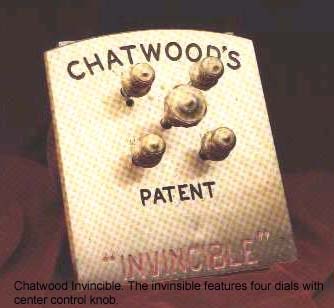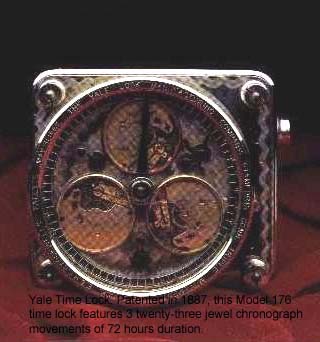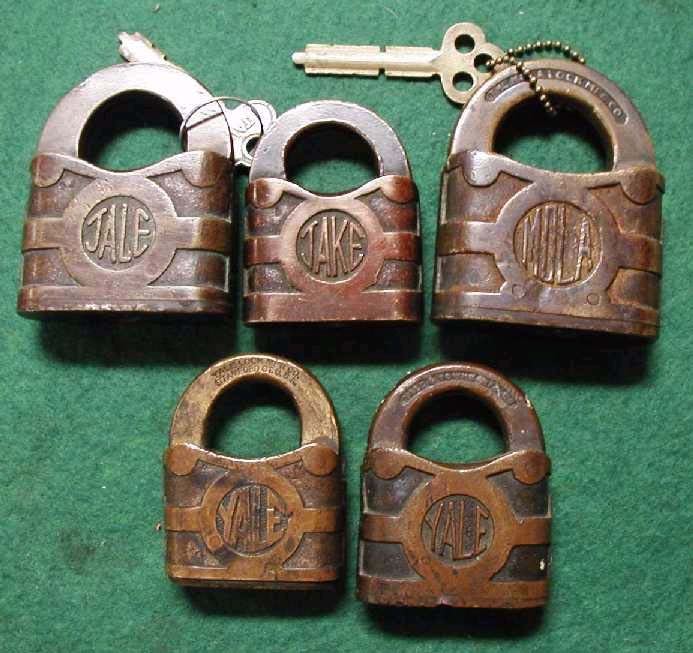| The main thing to
remember is that the value of a lock or key is the price you can sell it
for. That price depends on many factors: condition, age, materials,
rarity, publicity. Mass market locks, made in the millions, are normally
of little interest to collectors, and are priced accordingly. However,
remember that it is each collector who determines what is collectible.
There are no rules, and you should feel completely free to collect
whatever interests you. Eventually you will likely become interested in
some specialty, whether of type, manufacturer, country, age, size,
material, etc.
 To
some extent collectors seem to persuade each other what a lock is worth.
Locks that have been highlighted in some way, such as by the publication
of a book, increase in value. Some locks, such as the "story" locks,
have reached the investment level, where the pleasure of ownership is
strongly enhanced by the anticipation of value growth. Always keep in
mind that all locks are to some extent an investment: unlike "one
generation" collectibles, some or all of the money you spend can be
recovered, and your decisions might well be influenced by your estimates
of future sale prices. To
some extent collectors seem to persuade each other what a lock is worth.
Locks that have been highlighted in some way, such as by the publication
of a book, increase in value. Some locks, such as the "story" locks,
have reached the investment level, where the pleasure of ownership is
strongly enhanced by the anticipation of value growth. Always keep in
mind that all locks are to some extent an investment: unlike "one
generation" collectibles, some or all of the money you spend can be
recovered, and your decisions might well be influenced by your estimates
of future sale prices.
Where do you buy locks? Anywhere that
antiques are sold: flea markets, antique shops and shows, even garage
sales. To enter lock collector paradise, go to one of the specialized
lock shows listed in the show calendar on this site. Personal contacts
with other collectors are a traditional and excellent way to buy, sell
and trade. Collecting is changing a little, of course: if you have
access to online auctions such as eBay, you can have an antique lock
show every day, but the downside is that you must compete with every
other collector with a keyboard, and some of them have very deep
pockets! |
|
Price Guides
The only comprehensive and currently maintained price guide for padlocks
is "The Padlock Collector", by Frank Arnall, sixth edition, 1996. All
others, although useful for reference, are hopelessly obsolete. It is
impossible to keep track of sale prices of thousands of locks in a
changing market. A listing of selected sales is published in the
quarterly WCLCA newsletter, but most sales cannot be monitored. |
| Condition: What to Look For
When buying a lock, look for gouges, scratches or indentations around
rivets, indicating that that the case has been opened. At the very least
give it the shake test. That is, hold the shackle firmly against the
case and shake the lock. If it rattles, there are broken internal parts
and you should walk away. Rap the side of the case gently against your
hand and then pull on the shackle. If it releases, the bolt spring is
broken. If a dealer misrepresents a lock, do not correct him: he may
already know, and in any case certainly doesn't want to hear it.
 Avoid
locks with large dents or any evidence of modification. Avoid locks that
have been dug. Locks with frozen shackles probably also have heavy
internal corrosion, and are a gamble. Avoid
locks with large dents or any evidence of modification. Avoid locks that
have been dug. Locks with frozen shackles probably also have heavy
internal corrosion, and are a gamble.
In the case of older lever locks, if there is no drop, look for a small
hole above the keyhole. If there is one, it was to attach a drop that is
now missing. The value is strongly affected, of course.
Try the key, if any. They don't necessarily work. If not, ask the seller
to try it. If it still doesn't work, ask for a discount!
But finally, consider the lock as a whole. Most locks have
imperfections. Rare and exotic locks of considerable value can be
forgiven many flaws. Every collector has some locks with problems, but
appreciates them anyway. Every collector has made mistakes, but rarely
mentions them!
|
| Fakes & Frauds
Fakes, reproductions, fantasies, etc.: these exist, but this site is not
an appropriate place to discuss them. Do not try to collect alone. Join
a collector organization. Get books and read them. Many fraudulent locks
have been identified, and continue to be exposed as they appear.
Newsletters and contacts with other collectors are your best protection
against funny locks. It seems that the scale of faking and forging is so
small that no legal barriers exist. "The law does not concern itself
with trifles". This may seem like cold comfort if you have just paid
hundreds of dollars for a piece of attractive junk. Which brings up
another rule of thumb: as a starting point, do not believe anything the
seller tells you. A dealer's story does not constitute a provenance, and
they can be incredibly creative!
|

Top row: fake Yales / Bottom row: genuine Yales
The fake Yales were patent ripoffs from the 1920's and sold
commercially. Their value has increased over the years to collectors.
The bottom left Yale logo looks like a fake, but is actually a early
Standard Yale from the patent series.
|

